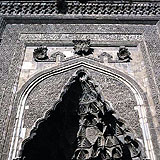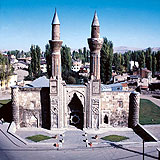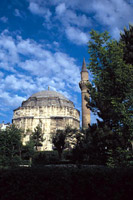Sivas
Ulu Mosque (Center): The mosque is located inside the city center at the quarter mentioned with the same name. According to the inscription exhibited in the Sivas Museum, the mosque is a Seljukian Period creation which was constructed between dates in 1196 - 1197 by the Scarlet Aslan bin İbrahim. The mosque is a typical and important sample of the Ulu Mosque style which were constructed during the reign of State Governments in Anatolia. The structure was constructed from the shear stones and has a plain artisanship.
 Gök Theological School (Center): The theological school is located inside the city center, to the southeast of Sivas Castle. The theological school was constructed by the Grand Visier of the Anatolian Seljukian Principality and “Father of Pious Foundations” (Ebu'l Hayrat) Sahip Ata Fahreddin Ali in the year 1271 as the theological school in whichthe astrology science was teached. Because of the blue tiles on the double minarets rising above the corolla gates,the structure was called as the Gök Medrese (Sky Theological School). The corolla gate, which is one of the wonders of the plastic art contains a major light - shadow system because of the marble material used in construction. The fountain, the windows, the reinforcement towers and the double minaret located at the frontai side of the structure enhances the importance of the corolla gate.
Gök Theological School (Center): The theological school is located inside the city center, to the southeast of Sivas Castle. The theological school was constructed by the Grand Visier of the Anatolian Seljukian Principality and “Father of Pious Foundations” (Ebu'l Hayrat) Sahip Ata Fahreddin Ali in the year 1271 as the theological school in whichthe astrology science was teached. Because of the blue tiles on the double minarets rising above the corolla gates,the structure was called as the Gök Medrese (Sky Theological School). The corolla gate, which is one of the wonders of the plastic art contains a major light - shadow system because of the marble material used in construction. The fountain, the windows, the reinforcement towers and the double minaret located at the frontai side of the structure enhances the importance of the corolla gate.
Kale (Castle) Mosque (Center): The mosque is located in the city center. The structure was constructed by Mahmut Pasha who was the governor of Sivas and one of the viziers of III. Sultan Murat in 1580. With its plan arrangement, architecture style, decoration elements and thin, long and elegant minaret, the mosque is the most beautiful mosque of the city remained from the Ottoman period.
was the governor of Sivas and one of the viziers of III. Sultan Murat in 1580. With its plan arrangement, architecture style, decoration elements and thin, long and elegant minaret, the mosque is the most beautiful mosque of the city remained from the Ottoman period.
Çifte Minareli Medrese (Double Minaret Theological School) (Center): The structure is located at the citycenter. The structure has rectangular plan and only the frontal section and the minarets are still standing in the present day. The stcructure was constructed by the İlhanlı vizier Sahip Şemseddin Mehmet Cüveyni in 1271. The structure has the biggest portal among the other theological schools in Anatolia.
Divriği Ulu Mosque and Darüşşifa (Lunatic Asylum and Hospital) (Divriği): The structure complex of Ulu Mosque and Darüşşifa (Lunatic Asylum and Hospital) are located at the south of the Divriği Castle and they are contiguous structures. The complex was constructed by Ahmet Shah, son of the Monarch of the Mengüçoğulları, Süleyman Şah in 1228. According to the Architectural respect, the structure had been taken under protection on the basis of "Protection of the Cultural Inheritance of the World ". The best quality samples of the stonemasonry and woodcarving can be found in this mosque. The structure displays different properties than the Anatolian Seljukian art with its characteristics of architecture and dec oration.
oration.
Kale (Castle) Mosque (Divriği): The mosque is located in the Divriği district. It was constructed in 1180 by Emir İshak, son of Süleyman Shah. Although the structure has a rich external appereance, the interior section is plain.